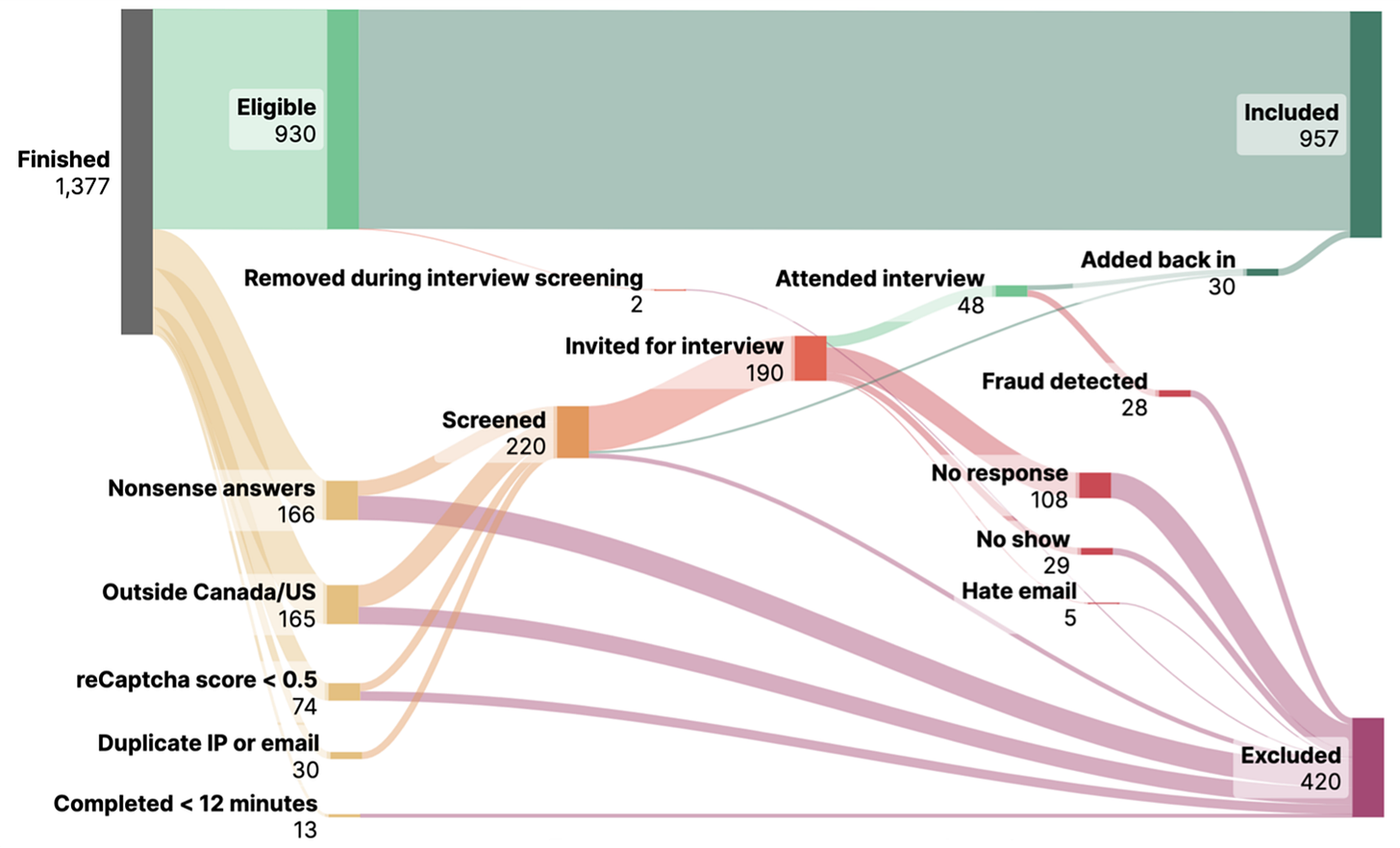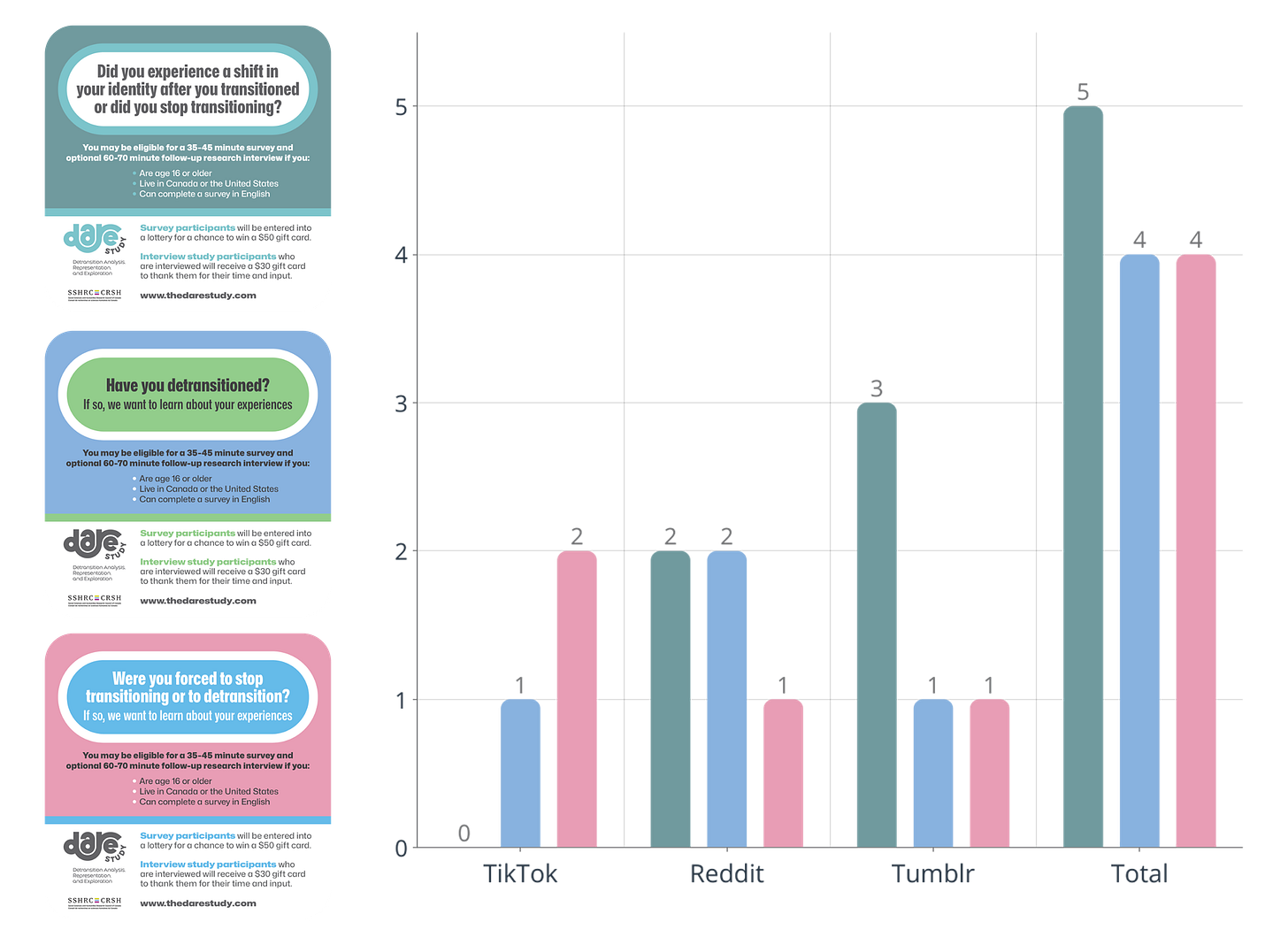A first look at the results of the largest detransition study to date: the DARE study
The DARE study's first paper is hot off the press! Today's post is a short summary of the main results
The DARE study’s first paper has been published in the Journal of Medical Internet Research. It’s quite difficult to study detransition in today’s polarized context, so this was a heavy lift!
Today’s article is a short summary of the full paper that was just published, complete with a few of the tables and figures. For a more detailed understanding of this groundbreaking study and its “Sisyphean” effort, check out the full paper here.
To know more about the DARE study, including research team composition and objectives, check out a prior post.
Everything you wanted to know about the DARE study
Detransition and transition “regret” have been written about in the academic literature, at least a little bit, since 1966, when Dr. Harry Benjamin published The Transsexual Phenomenon. In 1998, the first formal study focused exclusively on detransition/regret (among adults) was
Researching detransition/retransition in the anti-trans political climate is really challenging
It can be difficult to study detransition-related experiences for many reasons, politics being one. First, there is a real risk of study results on transition/detransition being weaponized or purposefully decontextualized by political actors in debates about transgender medicine.
But beyond this fact, there are varying understandings of the terms “detransition” and “retransition” themselves. What detransition/retransition means to people across the 2SLGBTQ+ spectrum can differ, especially based on whether someone has lived experience.
Generally, detransition is used to refer to a wide range of experiences inclusive of stopping, shifting, or reversing the social, legal, and/or medical interventions taken for an initial gender transition. But some people who have a shift in their gender identity/expression after gender transition use “retransition” instead to describe their experiences. Others reserve this term to refer to people who have transitioned, detransitioned, and then restarted a gender transition again. These are experiences that do not yet have a lot of research but are emerging across sexual and gender diversity.
Research is further challenged by the real stigmatization of detransition experiences, inconsistent use of concepts by researchers, and other factors like bots, scammers, and anti-trans/anti-detrans hate (this has been affecting 2SLGBTQ+ researchers aiming to promote research study opportunities online for several years now).
The DARE (Detransition Analysis, Representation, and Exploration) study was precisely designed to overcome some of these challenges, and that is what this new paper primarily covers.
To complete a comprehensive study, the study team’s main goal was to reach a diverse sample by targeting multiple groups with a wide range of experiences. In doing this, the DARE study aimed collect data on and build knowledge about experiences and needs of people who self-conceptualize as having experiences of detransition/retransition/identity shifts.
Eligibility criteria was aimed at including divergent experiences and identities. To take the survey, participants had to meet the following criteria:
Be at least 16 years old.
Reside in the US or Canada.
Be able to complete the survey in either English, French, or Spanish.
Identify as having a life experience of stopping, shifting, or reversing a gender transition, or desiring to detransition but feel unable to take any steps
Provide written informed consent.
The DARE study included experiences of social transition only, medical transition only, and social + medical transition. This understanding of detransition was built from prior research. The study itself collected data on life experiences through transition, detransition, and retransition.
As part of its aim of examining pathways to detransition, it included a question on reasons for detransition that covered 21 different possibilities. These included a mix of internal, systemic/external, psychological, and social reasons that may be related to a detransition/retransition/non-linear pathway.
The study was inclusive of those who understood their detransition as having been forced by external factors, like lack of support, discrimination, and the political context, such as losing access to medical treatments. It was also inclusive of those who felt they had a negative experience with transition, who felt misdiagnosed, and who now have regret.
There were also many questions covering satisfaction with transition and outcomes of medical treatment.
How did the survey participants learn about the study?
Recruitment of participants was largely done through online channels, such as social media. Both paid advertisements and regular posts were used across a variety of platforms, such as Reddit, Tumblr, X/Twitter, Instagram, Facebook, and TikTok.
Flyers advertising the study were shared in private Facebook groups related to gender diverse health care, detransition-related experiences, and transgender-related experiences, including parent groups for trans youth. Flyers were also posted to 30 different subreddits focused on both trans and detrans online spaces, and generalist channels.
Over $7,500 CAD/$5,500 USD was spent on paid advertising across social media!
In addition to social media advertising, more than 615 direct invitations were e-mailed to trans and/or 2SLGBTQ+ health care providers and organizations and gender care providers.
The survey was designed by the DARE study team, which is majority 2SLGBTQ+ (mostly trans, nonbinary, and detransitioned researchers). The survey was reviewed for language accuracy by one person with experience of detransition, and was pilot tested by four people with experiences of detransition (as well as members of the research team). It was also translated and pilot tested in French and Spanish to be accessible in multiple languages.
Challenges and controversies during study promotion
One challenge, as previously mentioned, was dealing with fraudulent/scam responses. This was managed through the study’s methodology, where suspicious survey responses (e.g., signs of bots or responses that did not make any sense) were e-mailed and offered a secondary screening process via Zoom video. This was to confirm they were a real human who was eligible to partake in the study. If they passed the Zoom screening, their data was included in the final dataset. Here is a Figure showing the scam/fraud/bot screening process:
Other challenges faced were likely due to the political polarization and mistrust of research on detransition. There were occasional hostile responses to recruitment posts, both from trans/nonbinary and gender critical/radical feminist online communities. These responses included skepticism of the principal investigator’s intentions because his research has been trans-inclusive, speculation that “grifters” were participating to push anti-trans views, and “disgust” at the fact that detransition was being studied at all.
During the study promotion phase, 13 paid advertisements were removed from several websites, notably on Tumblr, TikTok, and Reddit (likely due to mass reporting of the ads). But ads were posted and stayed up on Instagram and Facebook without issue. In the end, the study did manage to reach its target sample size of between 500-1,000 responses (total n=957)! These are all the ads that were removed, per platform:
Who took the survey? A look at demographics
Most participants reported learning about the study on Tumblr, Reddit, or Instagram/Facebook:
The median age of the sample was 24 years old, the mean/average was 26.
A majority identified as white or of European-descent, with roughly 22% reporting being racialized and/or multi-racial.
A large majority of the sample (79%) was assigned/observed female at birth.
A vast majority of the sample was 2SLGBTQ+, with ~11% endorsing a straight or heterosexual identity; 57% endorsed plurisexual identities (bisexual or pansexual).
Participants could identify with more than one of the following: ~33% were nonbinary, ~43% transgender, and ~40% identified as detransitioned, with a substantial portion selecting “unsure” to all of these identity labels.
The majority of participants were located in the US, with 74% in the US and 26% located in Canada. Most areas of both countries were represented, though no participants were included from the Northern territories of Canada, Prince Edward Island, Alaska, North Dakota, Wyoming, or Mississippi.
Concluding thoughts
With the subject of detransitioning increasingly discussed in society and seen in 2SLGBTQ+ communities, it is crucial to have robust and inclusive data. Despite some challenges and setbacks throughout the recruitment period, the DARE study achieved its goal of reaching a broad and divergent group of people with lived experience of transition/detransition/retransition.
Although finer-grain analyses are in progress and not yet peer-reviewed, the sample composition does show some broad similarities to other studies on detransition conducted in the last ~5 years, which we have posted about previously:
What does research say about factors associated with detransitioning?
Research can help us make sense of people and populations in societies. As academics, we’re trained to look for patterns in data—identifying which elements repeat over time, and to compare and contrast findings across multiple studies.
A very big thank you to everyone who took part in the survey, whether it was to cast a vote on the study name (the DARE study), pilot testing, helping to spread the word, or taking it.
This is an important study for 2SLGBTQ+ communities to help us all better understand experiences that are often misunderstood but included within experiences of sexual and gender diversity.
Thank you for reading The One Percent!
If you enjoyed this post, please share it with your friends, family, or colleagues:
You can also subscribe for free to receive new posts and support our work:












I appreciate that a good faith effort is being put into understanding detransitioners, why they detransition, and how they can be better supported by the medical community as a result. Thank you for doing this work. I can’t imagine it’s easy in this political climate.
I'm excited for the specific analysis to go public.